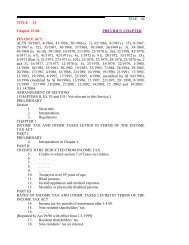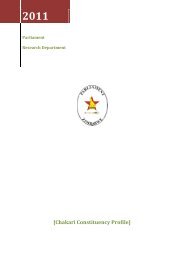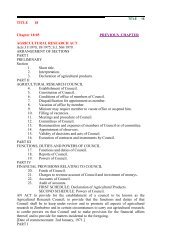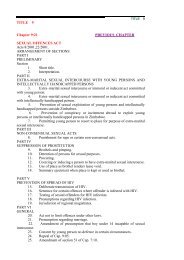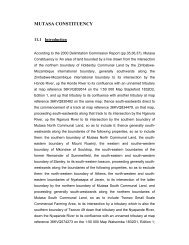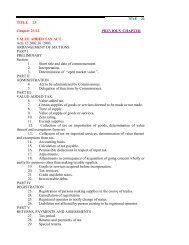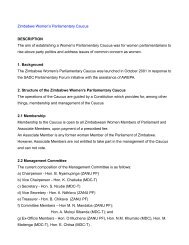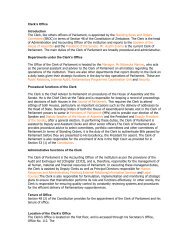Silobela Constituency Profile - Parliament of Zimbabwe
Silobela Constituency Profile - Parliament of Zimbabwe
Silobela Constituency Profile - Parliament of Zimbabwe
Create successful ePaper yourself
Turn your PDF publications into a flip-book with our unique Google optimized e-Paper software.
2011<br />
<strong>Parliament</strong><br />
Research Department<br />
[<strong>Silobela</strong> <strong>Constituency</strong> <strong>Pr<strong>of</strong>ile</strong>]
Table <strong>of</strong> Contents<br />
1.0 Introduction .................................................................................................................................................................. 3<br />
2.0 Population ...................................................................................................................................................................... 3<br />
3.0 Education........................................................................................................................................................................ 4<br />
3.1 Primary Education ................................................................................................................................................. 4<br />
3.2 Secondary Education ............................................................................................................................................ 6<br />
4.0 Health ............................................................................................................................................................................... 7<br />
5.0 Animal Health ............................................................................................................................................................... 8<br />
6.0 NGOs ................................................................................................................................................................................. 9<br />
7.0 Business Centres ...................................................................................................................................................... 10<br />
8.0 Water Points .............................................................................................................................................................. 10<br />
9.0 Local Government .................................................................................................................................................... 11<br />
10.0 Conclusion ................................................................................................................................................................... 12<br />
11.0 Recommendations ................................................................................................................................................... 12<br />
Bibliography ............................................................................................................................................................................. 13<br />
List <strong>of</strong> Figures<br />
Figure 1: Population Composition by Gender .................................................................................................................... 3<br />
Figure 2: Population Distribution by Ward ......................................................................................................................... 4<br />
Figure 3: Primary School Enrolment by Ward ................................................................................................................... 5<br />
Figure 4: Secondary School Enrolment by Ward .............................................................................................................. 6<br />
Figure 5: Dip tank Based Cattle Distribution by Ward ................................................................................................... 8<br />
Figure 6: Number <strong>of</strong> Dip Tanks by Ward .............................................................................................................................. 9<br />
List <strong>of</strong> Tables<br />
Table 1: Primary School Statistics ........................................................................................................................................... 5<br />
Table 2: Health Facilities in the <strong>Constituency</strong> .................................................................................................................... 7<br />
Table 3: NGOs Operating in the <strong>Constituency</strong> .................................................................................................................... 9<br />
Table 4: Major Business Centres ........................................................................................................................................... 10<br />
Table 5: Water Points ................................................................................................................................................................ 10<br />
Table 6: Councilors in the Constituencies ......................................................................................................................... 11<br />
<strong>Silobela</strong> <strong>Constituency</strong> <strong>Pr<strong>of</strong>ile</strong> Page 2
1.0 Introduction<br />
<strong>Silobela</strong> is a rural constituency found in the Midlands Province and consists <strong>of</strong> major areas such as<br />
Ntombe, Cross words, <strong>Silobela</strong>, Jena and Donsa. Ndebele speaking people dominate the region and<br />
are dominantly poor, (<strong>Zimbabwe</strong> Election Support Network, 2008)<br />
2.0 Population<br />
The proportion <strong>of</strong> male and female population was 48 and 52 percent respectively in Midlands<br />
Province. The average rate <strong>of</strong> natural population increase stands at 1.26 percent, crude birth rate<br />
was at 31.29 births per 1000 while crude death rate stands at 18.64 deaths per 1000 in 2002. Gokwe<br />
South contributed about 20 percent <strong>of</strong> the total population in the province whilst the other districts<br />
provide between 1 and 15 percent.<br />
<strong>Silobela</strong> constituency has a population <strong>of</strong> 66 792 people comprising <strong>of</strong> 32 416 males and 34 376<br />
females. The population is housed in about 12 815 house holds with an average house hold size <strong>of</strong> 4<br />
people. Amongst the population, 31 510 are registered voters giving an average <strong>of</strong> 2 101 registered<br />
voters per ward.<br />
Figure 1: Population Composition by Gender<br />
<strong>Silobela</strong> <strong>Constituency</strong> <strong>Pr<strong>of</strong>ile</strong> Page 3
The graph above shows that the distribution <strong>of</strong> population at constituency level reflects the<br />
provincial demographic distribution <strong>of</strong> more females to males. As shown by the graph below, most<br />
wards have more females to males. All <strong>of</strong> the constituency wards has a population above 1 800<br />
people.<br />
Figure 2: Population Distribution by Ward<br />
Ward 25 has the highest number <strong>of</strong> registered voters while ward 26 has the least. There is a slight<br />
relationship between population distribution and distribution <strong>of</strong> registered voters in the<br />
constituency. A significant drop had been registered in election participation from 21 061 voters in<br />
2005 to 11 544 in 2008.<br />
3.0 Education<br />
3.1 Primary Education<br />
In <strong>Zimbabwe</strong> there are high levels <strong>of</strong> primary school enrolments, net enrolment ratio (NER)<br />
increased from 81.9% in 1994, peaking at 98.5% in 2002. Council schools enrol about 61% <strong>of</strong> the<br />
population whilst government schools are the second largest enroller <strong>of</strong> about 24%. Gender equality<br />
<strong>Silobela</strong> <strong>Constituency</strong> <strong>Pr<strong>of</strong>ile</strong> Page 4
at primary schools is also good. However, quality <strong>of</strong> education deteriorated between 1990 and 2009<br />
due to the harsh economic environment that was prevailing in the country. About 17% <strong>of</strong> the pupils<br />
walk more than 5km to attain primary education in Midlands Province.<br />
<strong>Silobela</strong> <strong>Constituency</strong> has 30 primary schools, enrolling a total <strong>of</strong> 17 597 pupils. About 8<br />
711(49.50%) <strong>of</strong> the pupils are girls whilst boys constitute a total <strong>of</strong> 8 886(50.50%) <strong>of</strong> the total<br />
enrolment. There are 487 teachers (both trained and untrained) in the constituency and the<br />
constituency pupil to teacher ratio stood at 37:1 which is above the national average. The primary<br />
teaching staff complement consists <strong>of</strong> 202 male teachers and 285 female teachers.<br />
Figure 3: Primary School Enrolment by Ward<br />
Generally, the graph above shows that more girls are enrolled at primary schools than boys, though<br />
the differences might be slight in other wards. All the constituency wards enroll at least 1 000 pupils<br />
serve for ward 26. Statistics also show that, <strong>of</strong> the total teaching staff, 430 are certified teachers.<br />
Table 1: Primary School Statistics<br />
Ward Schools Boys Girls Total Trained<br />
Teachers<br />
Ward 4 7 1351 1380 2731 74<br />
Ward 5 5 1051 970 2021 40<br />
Ward 15 6 710 728 1438 35<br />
Ward 17 5 1115 1051 2166 52<br />
<strong>Silobela</strong> <strong>Constituency</strong> <strong>Pr<strong>of</strong>ile</strong> Page 5
Ward Schools Boys Girls Total Trained<br />
Teachers<br />
Ward 18 3 618 625 1243 36<br />
Ward 19 2 359 343 702 21<br />
Ward 20 5 830 863 1693 41<br />
Ward 21 3 712 654 1366 30<br />
Ward 25 2 502 504 1006 23<br />
Ward 26 1 224 225 449 11<br />
Ward 27 3 710 738 1448 31<br />
Ward 28 4 704 630 1334 36<br />
Totals 46 8886 8711 17597 430<br />
3.2 Secondary Education<br />
There are about 3 secondary schools in the constituency enrolling a total <strong>of</strong> 1 184 pupils. About 44,<br />
both trained and untrained teachers provide secondary education in the constituency, giving an<br />
average pupil to teacher ratio <strong>of</strong> 26:1 for the constituency. Generally, more girls are enrolled for<br />
secondary education than boys in the constituency. All the schools provide day sessions and are<br />
owned by rural district council with the first established in 1981.<br />
Figure 4: Secondary School Enrolment by Ward<br />
<strong>Silobela</strong> <strong>Constituency</strong> <strong>Pr<strong>of</strong>ile</strong> Page 6
Tiger Reef<br />
Clinic<br />
Maryoca<br />
Nyoni Rhc<br />
Sigezibubi<br />
Donsa Rhc<br />
Exchange<br />
Simana<br />
Msilahobe<br />
Malisa<br />
Josefa<br />
Mazembe<br />
4.0 Health<br />
There are 5 clinics and 5 rural health service centres in <strong>Silobela</strong> constituency. Most <strong>of</strong> the health<br />
centres have internal roads though access roads are not provided. Tiger Reef clinic and Nyoni<br />
Health Service Centre are connected to ZESA grid although none <strong>of</strong> the centres has a vehicular<br />
services as depicted in the table below. Most <strong>of</strong> the facilities have access to communication<br />
networks. Communication together with fire protection is also a major challenge to all these health<br />
facilities and hospital equipment is not existent.<br />
Table 2: Health Facilities in the <strong>Constituency</strong><br />
Centre Name<br />
Wards 4 5 15 17 18 19 20 25 27 28<br />
Status Clinic RHC RHC Clinic RHC Clinic Clinic RHC Clinic RHC<br />
Nurses 3 2 2 1 0 2 2 3 2 2<br />
General Beds 0 4 10 3 0 15 3 0 5 6<br />
Access Road yes no yes no no yes<br />
Communicatio yes yes yes yes yes no<br />
ns<br />
Fire Protection yes no no no no no<br />
Internal Roads yes no yes yes yes yes<br />
Fencing yes yes yes no yes yes<br />
Power Supply yes no yes no no no<br />
Water Supply no no no yes yes yes<br />
<strong>Silobela</strong> <strong>Constituency</strong> <strong>Pr<strong>of</strong>ile</strong> Page 7
5.0 Animal Health<br />
There are 46 801 cattle in the whole constituency, 12 Animal Health Centers and 39 dip tanks<br />
within <strong>Silobela</strong> constituency. Ward 17 has the largest herd <strong>of</strong> cattle whilst ward 20 has the least.<br />
Figure 5: Dip tank Based Cattle Distribution by Ward<br />
The graph below closely shows that there is no relationship that exists between cattle and dip tank<br />
distribution. Ward 17 with the highest number <strong>of</strong> cattle has 3 dip tanks whilst ward 25 with the<br />
second largest herd has 5 dip tanks, a number equal to dip tanks in ward 26.<br />
<strong>Silobela</strong> <strong>Constituency</strong> <strong>Pr<strong>of</strong>ile</strong> Page 8
Figure 6: Number <strong>of</strong> Dip Tanks by Ward<br />
6.0 NGOs<br />
A total <strong>of</strong> five non governmental organisations provide various activities in Kwekwe and Redcliff<br />
districts, and these include Plan International and Oxfam among others. Most <strong>of</strong> the organizations<br />
take part in child welfare programmes, agriculture, education, food distribution and poverty<br />
alleviation whilst WFP take part in institutional support.<br />
Table 3: NGOs Operating in the <strong>Constituency</strong><br />
Name<br />
Ward <strong>of</strong> Activity<br />
activity<br />
WFP District Wide Institutional support<br />
Plan International District Wide Child welfare<br />
Care International District Wide Education, Agriculture<br />
Oxfam District Wide Food Distribution<br />
IOM District Wide Food Distribution<br />
Orap District Wide Poverty Alleviation<br />
<strong>Silobela</strong> <strong>Constituency</strong> <strong>Pr<strong>of</strong>ile</strong> Page 9
7.0 Business Centres<br />
There are 7 business centers in the <strong>Silobela</strong> constituency. Half <strong>of</strong> the major business centers are<br />
electrified, namely Mkobongwe, Simana, Crossroads and Ruya. A post <strong>of</strong>fice is located at<br />
Crossroads Rural service centre. All the business centres have got retailing outlets with the<br />
exception <strong>of</strong> Bamala.<br />
Table 4: Major Business Centres<br />
Centre Status Electrification Post Office Retailing<br />
Outlets<br />
Donsa Bc Yes<br />
Mkobongwe Bc Yes Yes<br />
Malisa Bc Yes<br />
Simana Bc Yes Yes<br />
Crossroads RSC Yes Yes Yes<br />
Bamala<br />
Bc<br />
Ruya Bc Yes Yes<br />
8.0 Water Points<br />
The constituency has a total <strong>of</strong> 365 boreholes and 38 deep wells from which residents draw water.<br />
Of the 365 boreholes, 312 are functional whilst 35 deep wells are also functional from a total <strong>of</strong> 38.<br />
Increasing the number <strong>of</strong> boreholes and deep-wells within the constituency will help to ease<br />
pressure on the existing ones. The presence <strong>of</strong> so many water points is an indication <strong>of</strong> the dry and<br />
arid nature <strong>of</strong> the constituency. Hence crop production is less compared to animal husbandry in this<br />
constituency.<br />
Table 5: Water Points<br />
Ward Ward Name Boreholes Functional<br />
Bore-Holes<br />
4 New<br />
37 21<br />
Resettlement<br />
5 Sessombi I 29 15<br />
Deep Wells<br />
Functional<br />
Deep Wells<br />
15 Sessombi II 13 10 1 1<br />
17 Kwaedza 39 30 2 1<br />
<strong>Silobela</strong> <strong>Constituency</strong> <strong>Pr<strong>of</strong>ile</strong> Page 10
Ward Ward Name Boreholes Functional Deep Wells Functional<br />
Bore-Holes<br />
Deep Wells<br />
18 Batanai 13 13 8 8<br />
19 Kubatana 27 25 5 5<br />
20 Sebenzani 24 24 11 11<br />
21 Mtshikitsha 51 47 4 3<br />
25 Msokeli 26 25 1<br />
26 Sessombi III 15 12 1 1<br />
27 Hlanganisa 50 49 1 1<br />
28 Inhlangano 41 41 4 4<br />
9.0 Local Government<br />
The constituency is represented by 12 councilors in local government <strong>of</strong> which all are males serve<br />
for Mrs Maratera <strong>of</strong> ward 19. There is no gender balance in local governance within the<br />
constituency. Most women still shun participation in governance issues as candidates and they need<br />
education and encouragement so that they can also stand as individuals in their own right.<br />
Table 6: Councilors in the Constituencies<br />
Ward Councillor Gender<br />
Number<br />
4 J.J.E Chademana M<br />
5 L. Siziba M<br />
15 R. Takawira M<br />
17 T.D Moyo M<br />
18 M. Ndere M<br />
19 E.B Maratera F<br />
20 N.P Ncube M<br />
21 J. Munjanja M<br />
25 S. Masendeke M<br />
26 M. Ncube M<br />
27 G. Nkomo M<br />
28 J. Mp<strong>of</strong>u M<br />
<strong>Silobela</strong> <strong>Constituency</strong> <strong>Pr<strong>of</strong>ile</strong> Page 11
10.0 Conclusion<br />
Infrastructure servicing calls for urgent attention in the constituency. There is need to empower<br />
residents through resource ownership and improvement in service delivery<br />
11.0 Recommendations<br />
Rehabilitation <strong>of</strong> dip tanks, schools and health facilities<br />
Promote institutions that provide HIV/AIDS related information.<br />
Promote small scale projects in the constituency.<br />
Residents to participate in economic activities such as mining.<br />
Non Governmental Organisations should provide development assistance not food “hand<br />
outs”, through assistance with inputs and raw materials.<br />
<strong>Silobela</strong> <strong>Constituency</strong> <strong>Pr<strong>of</strong>ile</strong> Page 12
Bibliography<br />
1. Central Statistical Office (CSO), 2002. Census 2002 Provincial <strong>Pr<strong>of</strong>ile</strong>: Midlands,<br />
Government <strong>of</strong> <strong>Zimbabwe</strong>, Harare<br />
2. Government <strong>of</strong> <strong>Zimbabwe</strong>, 2006. <strong>Zimbabwe</strong> 2003 Poverty Assessment Study Survey<br />
Summary (PASS) Report, Ministry <strong>of</strong> Public Service , Labour and Social Welfare, July 2006,<br />
Harare.<br />
3. Government <strong>of</strong> <strong>Zimbabwe</strong>, UNDP, 2010. 2010 Millennium Development Goals Status Report,<br />
Ministry <strong>of</strong> Labour and Social Services, UNDP, Harare.<br />
4. <strong>Zimbabwe</strong> Election Support Network (ZESN), 2008, A <strong>Pr<strong>of</strong>ile</strong> <strong>of</strong> Constituencies:<br />
Understanding Elections in <strong>Zimbabwe</strong>, ZESN, Harare.<br />
5. <strong>Zimbabwe</strong> Electoral Commission (ZEC), 2008. The Report on the Delimitation Exercise for<br />
the 2008 Harmonised Elections, Government <strong>of</strong> <strong>Zimbabwe</strong>, Harare.<br />
6. <strong>Zimbabwe</strong> Vulnerability Assessment Committee (ZimVac), 2009 ZimVac Rural Household<br />
Livelihoods Survey Report No.11, October 2009, Harare.<br />
<strong>Silobela</strong> <strong>Constituency</strong> <strong>Pr<strong>of</strong>ile</strong> Page 13



